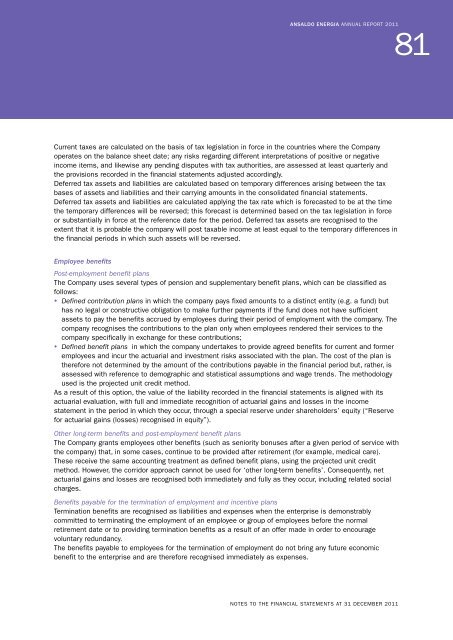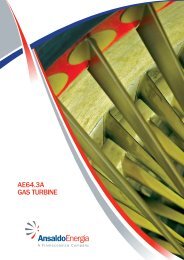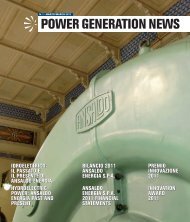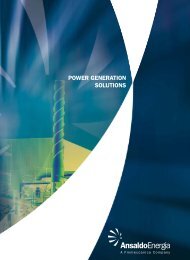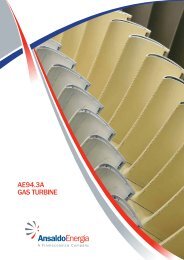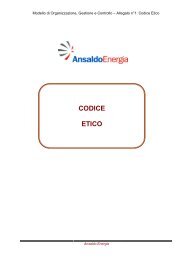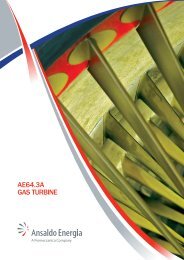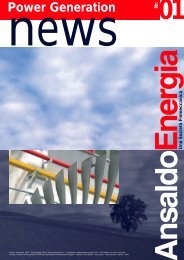Bilancio Ansaldo - Ansaldo Energia
Bilancio Ansaldo - Ansaldo Energia
Bilancio Ansaldo - Ansaldo Energia
You also want an ePaper? Increase the reach of your titles
YUMPU automatically turns print PDFs into web optimized ePapers that Google loves.
ANSALDO ENERGIA ANNUAL REPORT 2011<br />
81<br />
Current taxes are calculated on the basis of tax legislation in force in the countries where the Company<br />
operates on the balance sheet date; any risks regarding different interpretations of positive or negative<br />
income items, and likewise any pending disputes with tax authorities, are assessed at least quarterly and<br />
the provisions recorded in the financial statements adjusted accordingly.<br />
Deferred tax assets and liabilities are calculated based on temporary differences arising between the tax<br />
bases of assets and liabilities and their carrying amounts in the consolidated financial statements.<br />
Deferred tax assets and liabilities are calculated applying the tax rate which is forecasted to be at the time<br />
the temporary differences will be reversed; this forecast is determined based on the tax legislation in force<br />
or substantially in force at the reference date for the period. Deferred tax assets are recognised to the<br />
extent that it is probable the company will post taxable income at least equal to the temporary differences in<br />
the financial periods in which such assets will be reversed.<br />
Employee benefits<br />
Post-employment benefit plans<br />
The Company uses several types of pension and supplementary benefit plans, which can be classified as<br />
follows:<br />
� Defined contribution plans in which the company pays fixed amounts to a distinct entity (e.g. a fund) but<br />
has no legal or constructive obligation to make further payments if the fund does not have sufficient<br />
assets to pay the benefits accrued by employees during their period of employment with the company. The<br />
company recognises the contributions to the plan only when employees rendered their services to the<br />
company specifically in exchange for these contributions;<br />
� Defined benefit plans in which the company undertakes to provide agreed benefits for current and former<br />
employees and incur the actuarial and investment risks associated with the plan. The cost of the plan is<br />
therefore not determined by the amount of the contributions payable in the financial period but, rather, is<br />
assessed with reference to demographic and statistical assumptions and wage trends. The methodology<br />
used is the projected unit credit method.<br />
As a result of this option, the value of the liability recorded in the financial statements is aligned with its<br />
actuarial evaluation, with full and immediate recognition of actuarial gains and losses in the income<br />
statement in the period in which they occur, through a special reserve under shareholders’ equity (“Reserve<br />
for actuarial gains (losses) recognised in equity”).<br />
Other long-term benefits and post-employment benefit plans<br />
The Company grants employees other benefits (such as seniority bonuses after a given period of service with<br />
the company) that, in some cases, continue to be provided after retirement (for example, medical care).<br />
These receive the same accounting treatment as defined benefit plans, using the projected unit credit<br />
method. However, the corridor approach cannot be used for ‘other long-term benefits’. Consequently, net<br />
actuarial gains and losses are recognised both immediately and fully as they occur, including related social<br />
charges.<br />
Benefits payable for the termination of employment and incentive plans<br />
Termination benefits are recognised as liabilities and expenses when the enterprise is demonstrably<br />
committed to terminating the employment of an employee or group of employees before the normal<br />
retirement date or to providing termination benefits as a result of an offer made in order to encourage<br />
voluntary redundancy.<br />
The benefits payable to employees for the termination of employment do not bring any future economic<br />
benefit to the enterprise and are therefore recognised immediately as expenses.<br />
NOTES TO THE FINANCIAL STATEMENTS AT 31 DECEMBER 2011


